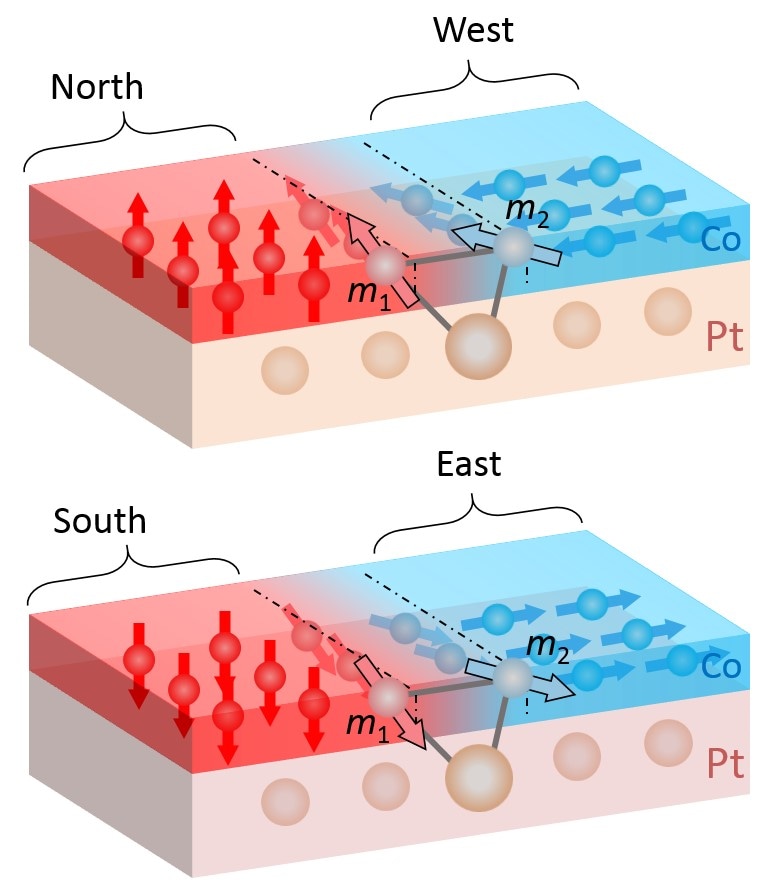Mar 29 2019
A team of scientists from ETH Zurich and the Paul Scherrer Institute (PSI) has identified a unique phenomenon of magnetism in the nanometer range.
 If a group of cobalt atoms aligns to the North or South (red), the neighboring cobalt atoms align to the West or East (blue). The orientation of the neighboring atoms is within the plane. This interaction requires sandwiching of the cobalt layer between a platinum layer (below, beige) and an aluminum oxide layer (above, not shown here). (Image credit: Paul Scherrer Institute/Zhaochu Luo)
If a group of cobalt atoms aligns to the North or South (red), the neighboring cobalt atoms align to the West or East (blue). The orientation of the neighboring atoms is within the plane. This interaction requires sandwiching of the cobalt layer between a platinum layer (below, beige) and an aluminum oxide layer (above, not shown here). (Image credit: Paul Scherrer Institute/Zhaochu Luo)
The phenomenon makes it possible to assemble magnets in extraordinary configurations. This can possibly be used for constructing switches and computer memories to boost the performance of microprocessors. The study results have been recently reported in the journal, Science.
It is a well-known fact that magnets are characterized by both south and north poles. Upon holding two normal magnets close to one another, like poles repel each other, and opposite poles attract each other. This is the reason why magnetic needles, like those seen in a compass, are able to align themselves in the magnetic field of Earth, so that they can be used to establish the fundamental directions South and North and, derived from this, West and East. This rule is accurate in the world that people experience daily with their senses. Conversely, this will change when people leave the macroscopic realm and dive into depths of relatively smaller dimensions. Now, scientists at the PSI and the ETH Zurich have identified a highly unique magnetic interaction at the level of nanoscopic structures composed of magnetic layers that measure just a few atoms thick.
These atoms behave like very small compass needles and unfold their impact across small distances in the nanometer range, implying a few millionths of a millimeter. This is the reason why they are also referred to as nanomagnets by researchers.
The special phenomenon now observed by the PSI team is based on an interaction that was predicted by two physicists Toru Mariya and Igor Dzyaloshinskii over six decades ago. According to Zhaochu Luo, a physicist at PSI and ETH Zurich, that interaction was their starting point.
North-West and South-East coupling of atoms
The atomic compass needles, in this interaction, are able to align in both North-South direction and East-West direction.
“Where the point depends on how the atoms in their neighbourhood orient themselves," informed the study’s first author Zhaochu Luo.
For instance, if a set of atoms points in the North direction, the adjacent group of atoms will always orient themselves to the West. Similarly, if a set of atoms points in the South direction, then the adjacent atoms will point to the East. Electric currents or magnetic fields can reverse such orientations, that is, from South to North and vice versa. Then, the adjacent groups of atoms reorient themselves consequently, either from East to West or vice versa.
The team noted the coupling of South-East and North-West orientations with the aid of a layer of cobalt atoms that had a thickness of just 1.6 nm, which was tightly packed between an aluminum oxide layer on one side and a platinum layer on the other. It took roughly six months to merely develop these unique layers for their experiments, stated Zhaochu Luo, who currently works in Laura Heyderman’s Mesoscopic Systems research group at PSI.
What is extraordinary about this is that such an interaction occurs only laterally, i.e., in one plane. Earlier, similar couplings between nanomagnets can only be identified vertically, with sets of atoms organized one over the other.
The unique phenomenon identified jointly by researchers from PSI and ETH Zurich allows the formation of planar magnetic networks. For example, synthetic antiferromagnets can be developed, among other things. In the synthetic antiferromagnets, groups of atoms point either South or North at consistent intervals. The opposing nanomagnets tend to neutralize one another in sum since their number is about the same. As a result, at initial glance, antiferromagnets do not behave like magnets—for instance, they cannot be fixed to a refrigerator door.
The adjacent atoms—oriented either to the East or to the West—behave as spacers isolating the magnets pointing South or North, each of which measures only a few nanometers. For instance, this makes it viable to develop new and more efficient switches and computer memories, which consecutively increase the performance of microprocessors.
Logical gates for computers
The separate nanomagnets, facing either the South or North direction, are appropriate for developing logic gates. A logic gate can be defined as a building block in a computer and works like a kind of switch. Signals entering these logic gates are subsequently processed into an output signal. A majority of these logic gates in a computer are networked to execute various operations. Such kind of a gate can even be developed using nanomagnets aligned to the South or North direction. These are similar to processors that are often utilized these days with transistors processing signals in binary form, which have the ability to interpret all signals as either one or zero. This can also be done by nanomagnets that are oriented either to the South or North direction. Perhaps, this can make microprocessors more efficient and compact.
According to Pietro Gambardella, who oversaw this study with Laura Heyderman, “this work provides a platform to design arrays of linked nanomagnets and achieve all-electric control of planar logic gates and storage devices,” as reported in Science.
The team obtained their results in the lab and also at the Swiss Light Source SLS at PSI.